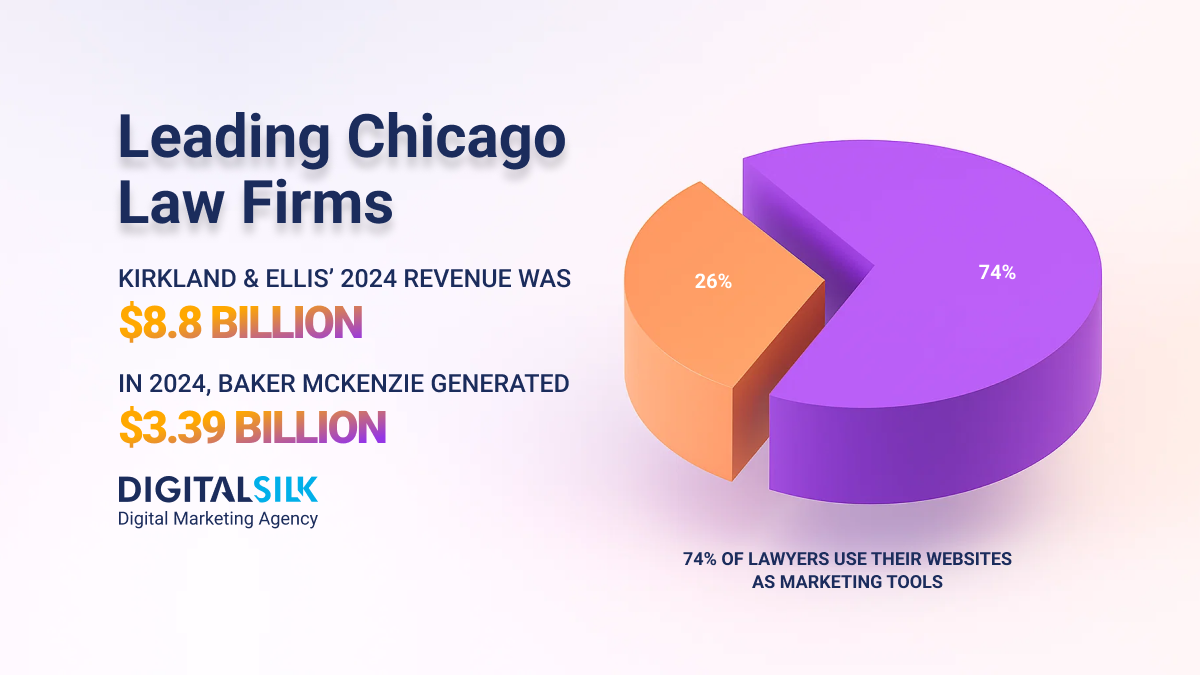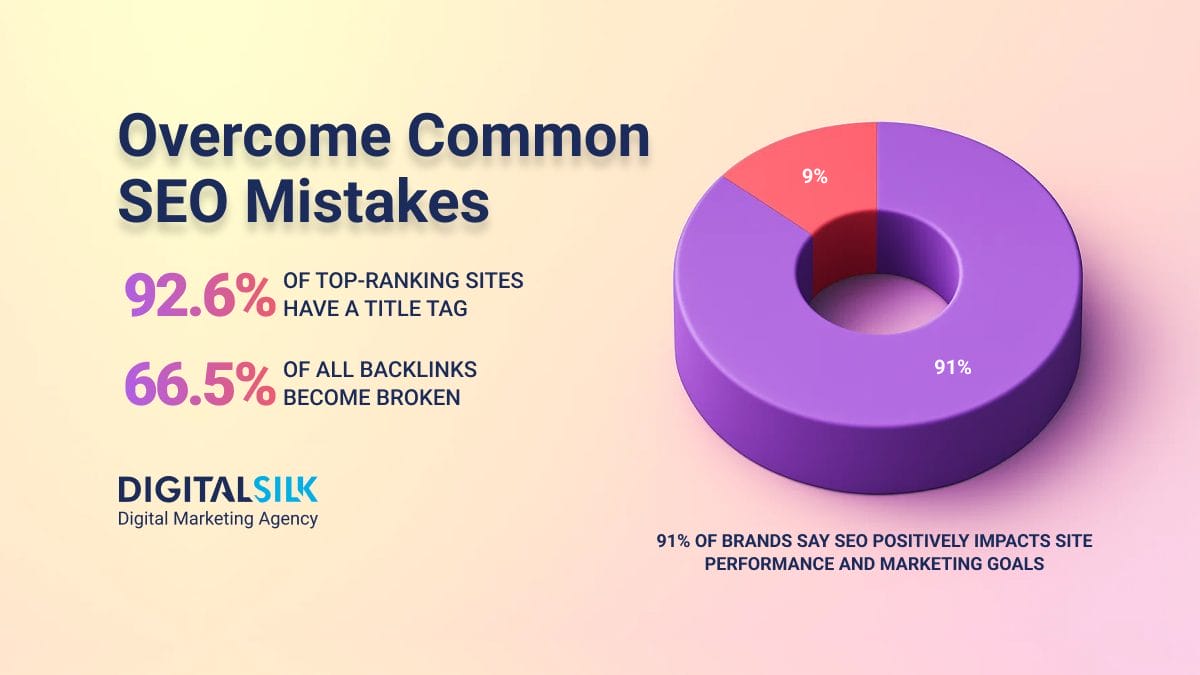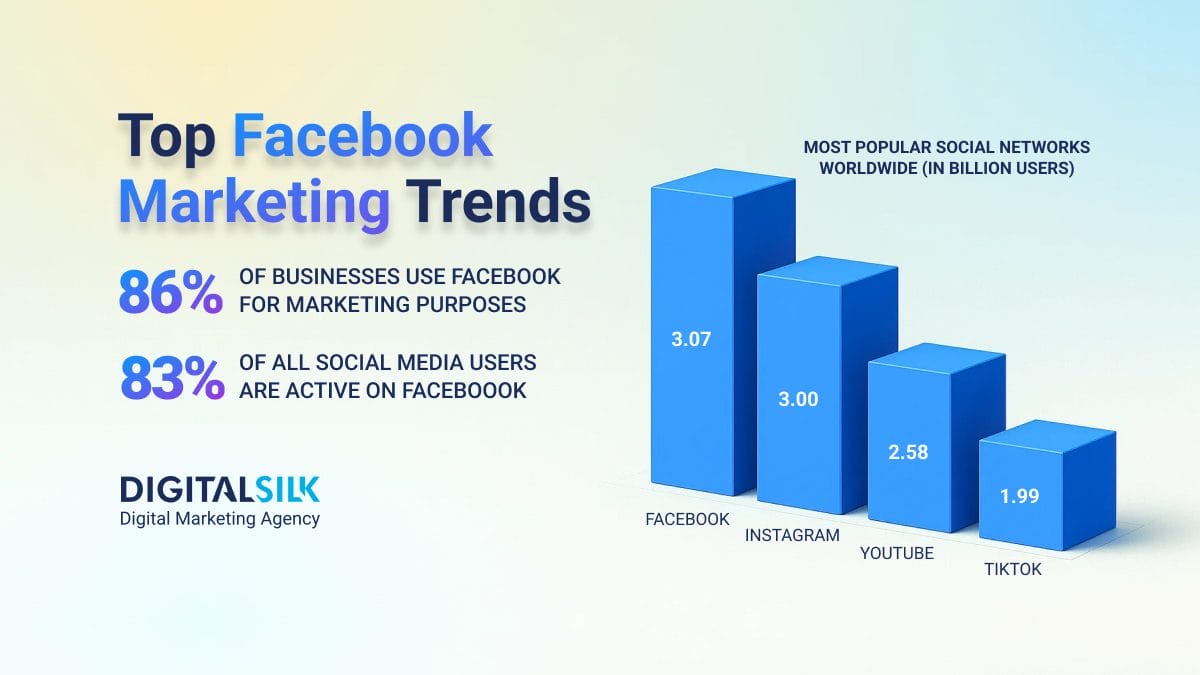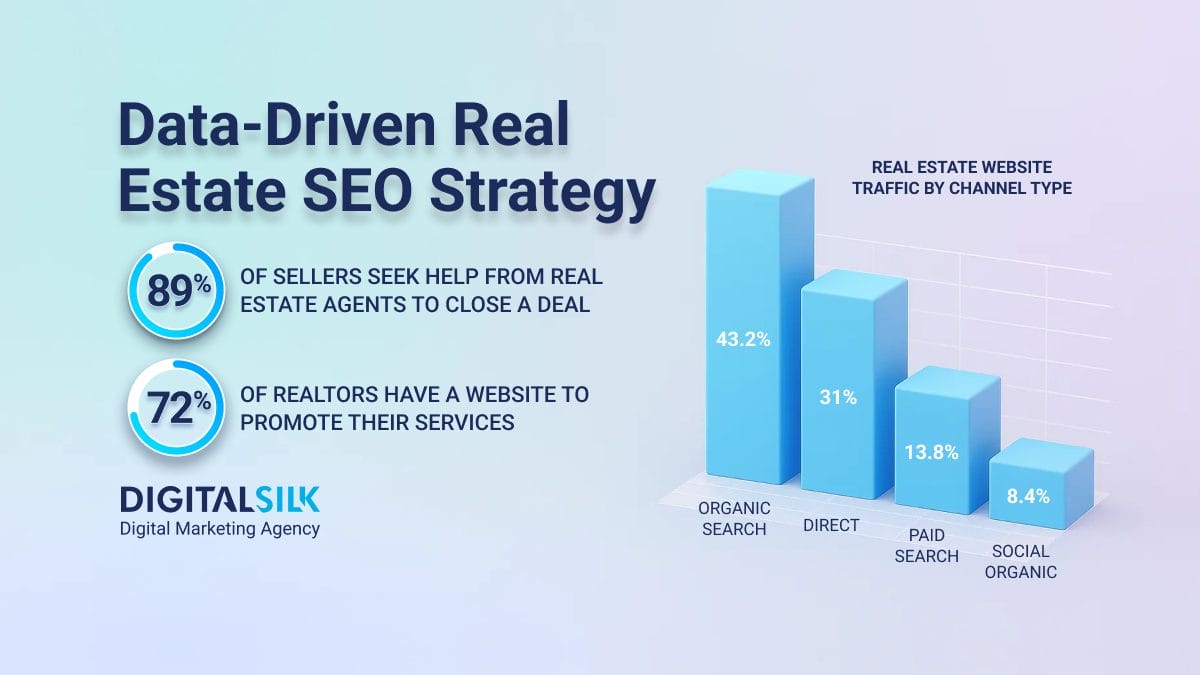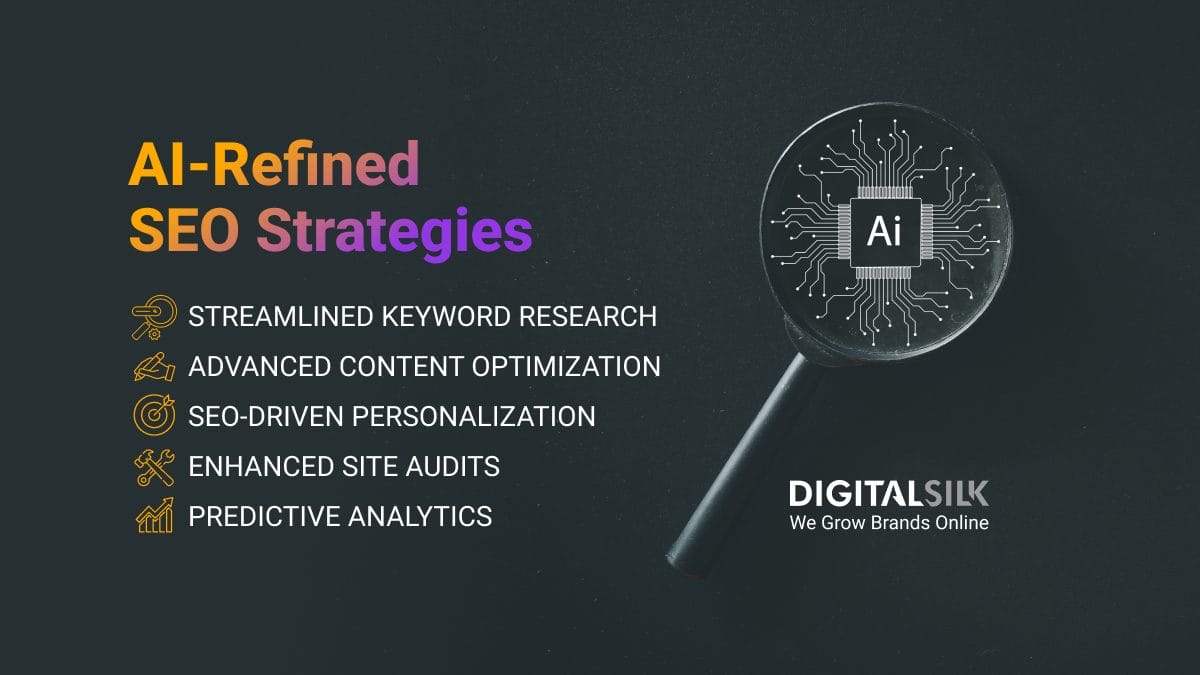Personal Injury Attorneys: Key Highlights
-
SEO builds long-term value: Unlike PPC, SEO delivers compounding returns that strengthen over time.
-
Local optimization is essential: City-specific landing pages and Google Business Profiles help law firms dominate regional searches.
-
Content strategy wins trust: Detailed practice pages, FAQs and blog content establish authority and attract high-intent clients.
In 2024, there were about 463,600 law firms in the U.S.
However, while clients are moving online, many personal injury firms are still not.
With 74% of people checking law firm websites before contacting anyone, SEO has become mission-critical for personal injury attorneys.
This 2025 guide lays out 13 proven SEO strategies designed to help personal injury lawyers avoid common mistakes:
- Dominate local and organic rankings
- Earn qualified traffic
- Attract high-intent clients
13 SEO Strategies For Personal Injury Lawyers
Below are 13 actionable strategies based on current search engine algorithms and consumer behavior patterns specific to the legal industry.
Each approach is designed to improve your visibility, attract qualified prospects, and ultimately drive more high-value cases to your firm.
1. Technical SEO Foundations
Technical performance is the foundation of a successful SEO strategy.
When your law firm website suffers from poor speed, security issues or crawling difficulties, even excellent content won’t save your rankings.
Priority technical initiatives for 2025:
- Site Speed Optimization: Compress images, remove unused code and enable browser caching. Modern clients expect pages to load in under two seconds — any longer and they’re clicking back to competitors.
- Mobile-first experience: With 68% of Google searches happening on mobile devices, your site must provide a seamless smartphone experience with tap-friendly navigation and properly sized text.
- HTTPS security: A secure connection is a ranking factor and a trust signal, especially for firms that collect sensitive information.
- Enhanced crawlability: Ensure your website follows a clear, logical structure with clean, readable URLs that facilitate easy navigation. Maintain an up-to-date XML sitemap and an optimized robots.txt file to help search engines understand which pages to index. Use tools like Google Search Console to monitor crawl errors and resolve indexing issues before they impact visibility.
Quick win: Conduct a technical audit using tools like PageSpeed Insights and Screaming Frog to identify and resolve the technical issues that are currently holding back your site’s performance.
GJEL Accident Attorneys demonstrates technical excellence with page load times of just 1.16 s and a clean, logical URL structure.
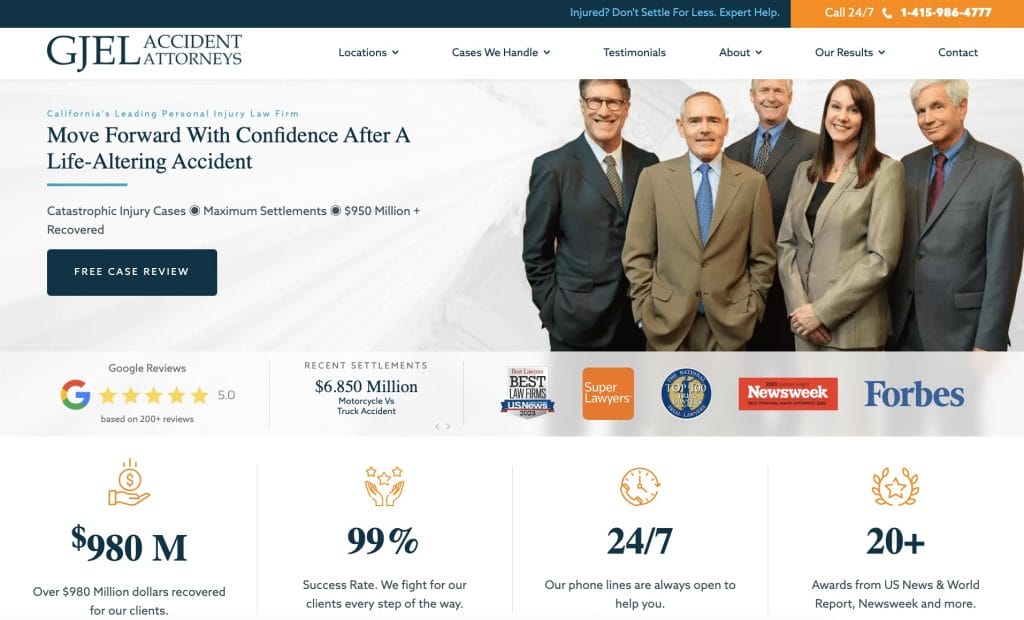
2. Improve Page Speed & Mobile Experience
To outrank your competitors, having a lightning-fast law website is paramount.
A one-second delay in page load time can reduce conversions by up to 20%.
Mobile users are especially impatient.
They’re often researching legal options during breaks, commutes or immediately following an incident.
A frustrating mobile experience can permanently redirect them to your competitors.
Optimization strategies that deliver results:
- Image optimization: Implement lazy loading to delay the rendering of images until users scroll to them, which can dramatically improve the initial page load speed. Convert images to modern formats like WebP to maintain quality while reducing file size by up to 30%.
- Minimize JavaScript and CSS: These code elements control your site’s functionality and appearance but can significantly impact load times when improperly implemented. Minify these files by removing unnecessary characters, combine multiple files where appropriate, and defer non-critical JavaScript until after the page renders. These technical adjustments can reduce load times by seconds.
- Responsive design: Rather than maintaining separate mobile and desktop experiences, implement a responsive design that adapts to any screen size, improving both user experience and SEO.
- Quality hosting: Invest in premium hosting with dedicated resources and robust security. Your hosting provider ultimately limits the performance potential of your site.
For example, Dreyer & Tinney’s website exemplifies simplicity and speed, achieving an almost perfect PageSpeed score of 99 on mobile devices. This high performance is complemented by effective search engine optimization strategies, contributing to their strong online presence.
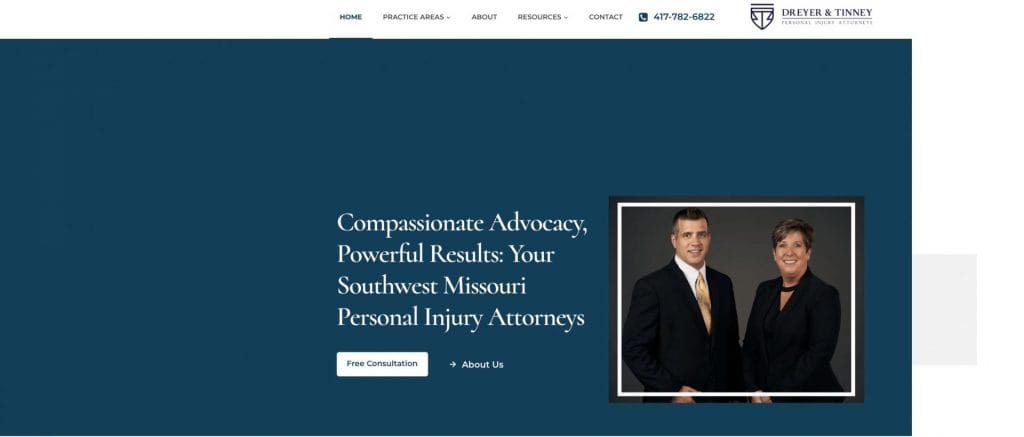
3. Use HTTPS And Enhance Crawlability
In an industry where trust is paramount, security signals like HTTPS are fundamental trust indicators that influence both search rankings and client confidence.
Implementation checklist:
- Strategic SSL certificate: While basic certificates provide encryption, invest in Organization Validated (OV) or Extended Validation (EV) certificates that verify your firm’s identity and display enhanced trust indicators to security-conscious prospects.
- Optimized URL structure: Create descriptive, keyword-rich URLs that clearly convey the page’s content. For personal injury practices, this means URLs like “/practice-areas/car-accidents/spinal-injuries/” rather than generic paths with ID numbers.
- Crawl efficiency: Search engines allocate limited “crawl budgets” to each site. Update your sitemap.xml regularly and use robots.txt strategically to ensure your highest-value pages receive maximum crawler attention.
- Search Console integration: Proactively submit your site to Google Search Console for indexing rather than waiting for passive discovery, and monitor crawl errors that might prevent specific pages from ranking.
Expert tip: Conduct quarterly crawl analyses to identify and remove thin or duplicate content that dilutes your crawl budget and potentially triggers search quality penalties.
For instance, Rosenbaum Personal Injury Lawyers uses site-wide HTTPS and features keyword-rich, human-readable URLs that support both SEO and user experience.
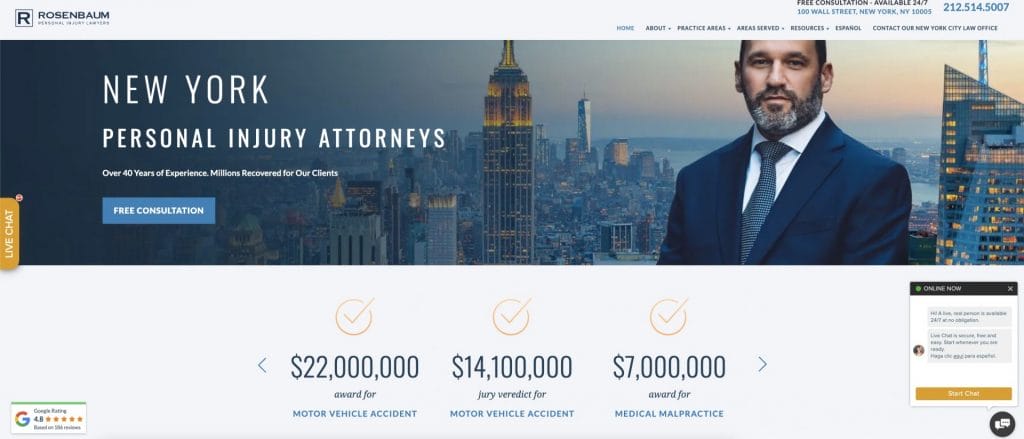
4. Smart Keyword Strategy & Content Mapping
Not all keywords deliver equal value.
High rankings for the wrong search terms waste resources while missing opportunities to attract qualified clients.
Focus areas:
- High-intent keywords: Target terms like “best car accident lawyer near me” or “hire personal injury attorney for slip and fall” that signal immediate need for representation.
- Geo-modified terms: Instead of competing nationally for broad phrases like “personal injury lawyer,” focus on geo-targeted variations such as “Austin truck accident lawyer” that match your actual service area.
- Long-tail specifics: Develop content for phrases like “statute of limitations for Illinois nursing home negligence” that attract prospects researching particular case types, often indicating higher-value claims.
- Strategic selection: Use tools like Ahrefs, Semrush or Keyword Planner to prioritize low-KD, mid-volume keywords aligned with commercial intent.
Pro implementation tip: Develop a comprehensive content matrix that maps primary and secondary keywords to specific pages.
This strategic organization ensures each page has a clear topical focus, preventing internal competition and maximizing ranking potential across your service offerings.
Zinda Law Group exemplifies effective keyword organization by clustering both conversion-focused “hire‑now” and informational research terms into service pages, blogs and FAQ hubs.
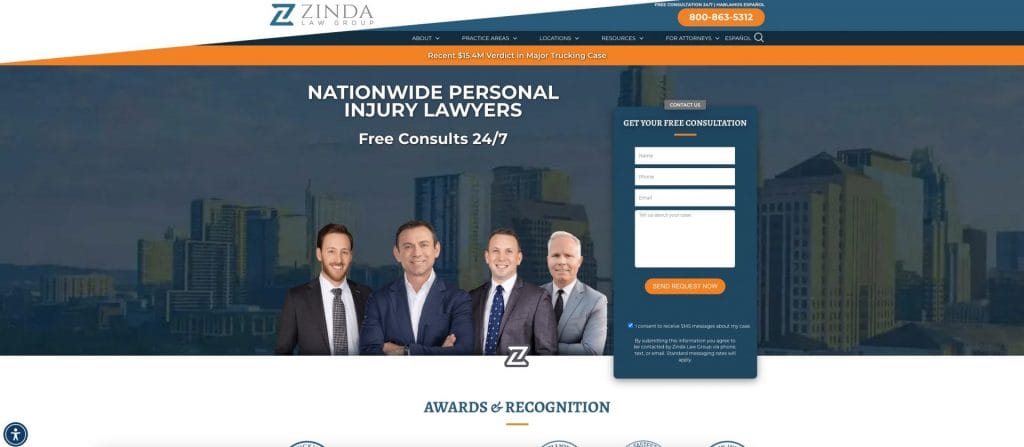
5. Create Location-Based Landing Pages
For personal injury attorneys, geographic relevance has a significant impact on both rankings and conversion rates.
Your firm likely has jurisdictional boundaries and clients strongly prefer attorneys familiar with local courts, judges and legal nuances.
Location-specific landing pages create powerful relevance signals for both search engines and potential clients.
Essential components of high-performing location pages:
- Detailed city-specific office information and maps
- Local legal nuances and citations
- Geo-relevant client testimonials
- Internal links to other relevant pages
For example, Morgan & Morgan is a large law firm with over 100 offices across the United States. The firm leverages its multi-state presence through strategically developed location pages for each of its offices, which helps it rank in local search results, connect with nearby clients through region-specific content and build trust by showcasing localized expertise and testimonials.
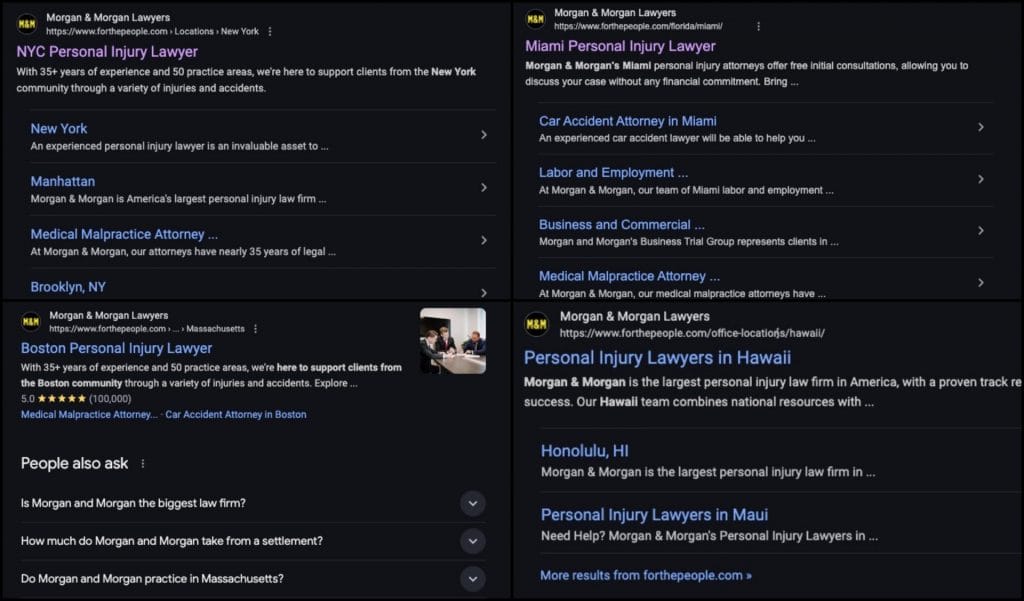
6. Optimize Your Google Business Profile (GBP)
The “local pack” — those prominent map listings displayed for location-specific searches — drives a disproportionate share of high-intent leads for personal injury firms.
In fact, firms with optimized Google Business Profiles are 2.7x more likely to earn trust from searchers.
If you’re not optimized for local search, you’re invisible when clients need you most.
What to optimize:
- Complete Google Business Profile: Fill out every field and use “Personal Injury Attorney” as your primary category with relevant secondary categories for specific practice areas. Create a keyword-rich description that naturally incorporates core services.
- Review management: Ask satisfied clients to leave reviews. Respond thoughtfully to all feedback, positive and negative, to demonstrate your attentiveness.
- Consistent citations: Ensure your NAP (Name, Address, Phone) info is consistent across all online directories, particularly legal-specific platforms like Avvo, Justia and Yelp.
- Localized content integration: Build city- and state-specific practice pages. Refer to local landmarks and laws to enhance local relevance.
AutoAccident.com – Law Offices of Edward A. Smith has masterfully executed this strategy, accumulating over 400 5‑star reviews and dominating Sacramento’s map pack results.
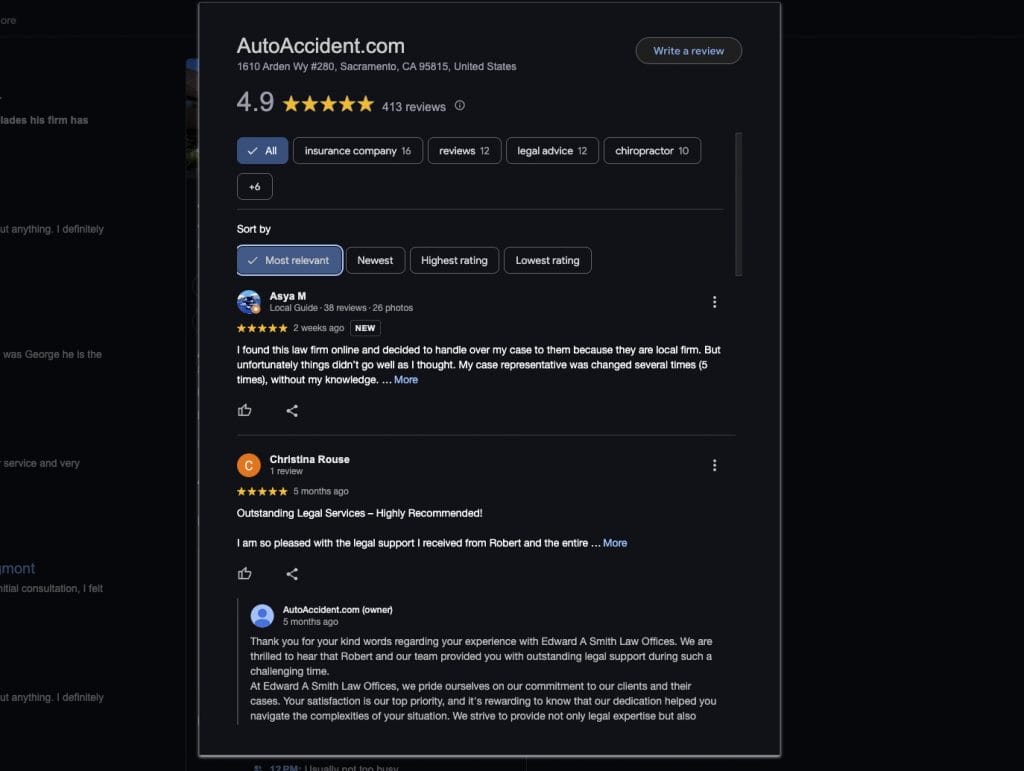
7. Publish Practice Area Pages And FAQs
Comprehensive service pages demonstrate expertise while answering critical questions potential clients have during their decision-making process.
The most effective firms develop robust content architectures that address both broad practice categories and specific injury scenarios, creating multiple entry points for prospective clients.
Content development essentials:
- Dedicated practice area pages: Create individual pages for each service offering (e.g., car accidents, medical malpractice), each containing 900-1,200 words of substantive content addressing processes, timelines and potential outcomes.
- FAQ sections: Develop comprehensive question-and-answer content addressing common client concerns, such as “What is my case worth?” or “How long do I have to file?” Structure these as dedicated topic hubs rather than lengthy single pages.
- Consistent content calendar: Maintain a consistent publishing calendar for blog content covering emerging legal trends, precedent changes and safety information relevant to your practice areas.
Pro tip: Apply structured data markup to FAQ content to increase your chances of appearing in featured snippets and voice search results for question-based queries.
The Perecman Firm’s exemplifies this approach with meticulously developed practice area pages for each service line, such as car accidents, construction accidents and medical malpractice, each approximately 900–1,200 words in length. These pages incorporate internal links to related content and utilize structured data markup (schema) to enhance search engine visibility.
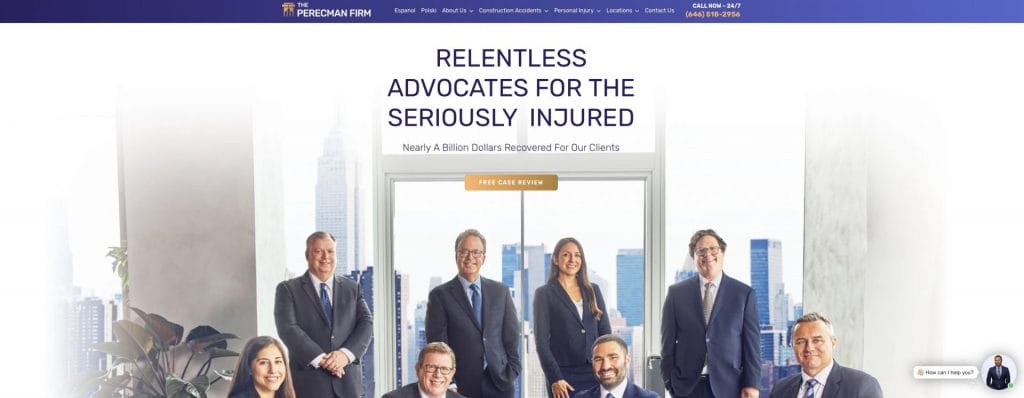
8. Share Case Studies & Legal Blog Content
Case studies and targeted blog content demonstrate real-world expertise while building search authority for your core practice areas.
What to include:
- Strategic case studies: Develop anonymized success stories showcasing particularly challenging legal situations you’ve navigated. Follow a clear structure: client situation, legal challenges, your approach and successful resolution.
- Local legal analysis: Create content addressing regional accident trends, court decisions affecting settlements or state law changes impacting injury claims.
- Actionable resources: Provide practical guides helping potential clients navigate immediate post-injury concerns, like “What to Do Following A Car Accident” or “Understanding Medical Documentation For Personal Injury Claims.”
Tip: Monitor consultation questions for content ideas that address genuine client concerns while naturally incorporating the terminology prospects actually use in their searches.
Salvi, Schostok & Pritchard effectively utilizes case studies and blog content to build authority and demonstrate results. Their regularly updated blog covers diverse topics relevant to personal injury law, including safety information, legal developments and insights into accident trends. This comprehensive content strategy enhances their visibility while providing valuable resources for potential clients navigating complex legal situations.
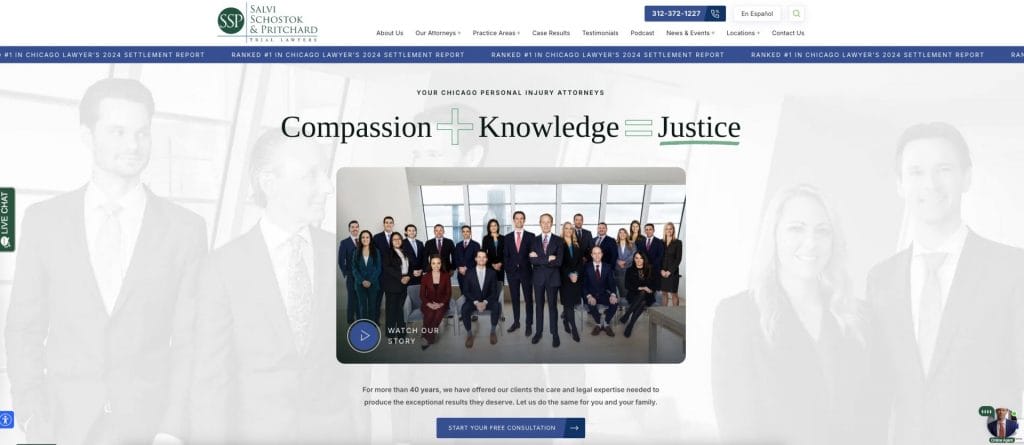
9. Authority-Building Backlinks
Top-ranking websites have 3.8x more backlinks than those ranked 2-10.
For personal injury firms, the quality and relevance of these backlinks are particularly crucial, with local authority signals carrying exceptional weight.
A strategic backlink profile doesn’t just improve ranking — it establishes your firm as a recognized authority within your legal community and geographic market.
Strategic link acquisition approaches:
- Legal directories: Claim and optimize comprehensive profiles on authoritative platforms like Justia, Avvo, HG.org and Martindale. Complete every available field and regularly update with new credentials.
- Thought leadership: Contribute expert analysis to bar association publications, legal news sites and industry journals to establish authority while earning quality backlinks.
- Digital PR: Develop relationships with local media outlets to secure coverage for noteworthy case results, community involvement initiatives or expert commentary on relevant legal developments.
- Community connections: Create partnerships with local organizations through sponsorships, scholarship programs or pro bono initiatives that generate authoritative local links while demonstrating community commitment.
Link Building Tip: Focus on acquiring links from websites that are topically relevant to either law or your local market, rather than pursuing high domain authority sites with no contextual connection to your practice.
10. Structured Data & Featured Snippets
As search interfaces evolve beyond traditional results pages, structured data and featured snippet optimization create opportunities for enhanced visibility.
These technical enhancements help search engines understand your content more precisely while securing prominent positions above traditional organic listings.
Key schema types:
- LegalService schema: Apply this markup to practice area pages, identifying service categories, payment methods, and geographic service areas.
- Attorney schema: Implement on biography pages to enhance visibility for name-specific searches and support appropriate display in knowledge panels.
- FAQPage schema: Use for question-and-answer content to increase eligibility for featured snippets and voice search results.
- Review schema: Where ethically permitted, incorporate aggregate review data to potentially display star ratings in search results.
Voice search optimization: Format critical information in concise, conversational 40-60 word segments that directly answer common legal questions. Structure these with clear headings and bulleted lists to increase featured snippet selection chances.
11. User Experience & Conversion Optimization
Driving qualified traffic only delivers value when your site effectively converts visitors into consultations and clients.
For prospects navigating stressful situations, a frictionless experience demonstrates your firm’s efficiency.
Optimization priorities:
- Intuitive site structure: Implement logical navigation with clearly labeled practice areas and contact options. Include search functionality and breadcrumb navigation that never places critical information more than three clicks from the homepage.
- Mobile-first design: Create tap-friendly navigation, properly sized text, and forms optimized for touchscreen completion. Test all interactive elements on multiple devices.
- Strategic CTAs: Position action-oriented prompts with benefit-focused language like “Get Your Free Case Evaluation” rather than generic “Contact Us” messaging. Place contact forms prominently above the fold on key pages.
- Trust signals: Strategically incorporate credibility indicators including bar certifications, case results (where permitted), and client testimonials to reduce perceived risk.
Personalized CTAs that reference specific practice areas or locations consistently outperform generic prompts, particularly for high-value services like personal injury representation.
For example, Ken Nugent, Attorneys at Law effectively employs conversion optimization with their distinctive “One Call, That’s All” bar and a 24/7 chat widget on every page. These elements are designed to enhance user engagement and accessibility, ensuring users that assistance is always one click away.

12. Track SEO KPIs & Conversion Data
The most successful firms approach SEO as a data-driven discipline, measuring performance against business objectives rather than vanity metrics.
Track the right KPIs:
- Traffic quality: Monitor not just overall organic volume but segment by geography, device type and landing page to identify which components drive relevant visitors.
- Ranking performance: Track keyword positions across practice areas and geographic targets, paying particular attention to movement in high-commercial-intent terms.
- Conversion actions: Implement proper tracking to identify which organic landing pages generate the most valuable client inquiries, connecting form submissions and calls to case management data.
- Local visibility: Monitor map pack performance across service areas using specialized tools like BrightLocal or Local Falcon for insights into geographic coverage.
Create monthly executive dashboards translating technical SEO metrics into business outcomes, helping firm leadership understand the connection between digital performance and client acquisition.
13. Monitor Algorithm Updates & E-E-A-T Signals
Google updates its algorithm regularly.
In 2023 alone, it ran over 4,000 improvements to Search.
For personal injury firms in the YMYL (Your Money or Your Life) category, maintaining alignment with evolving standards is critical.
The expertise, experience, authoritativeness and trustworthiness (E-E-A-T) of your content directly impacts your visibility for high-stakes legal queries.
Stay compliant with:
- E-E-A-T: Strengthen expertise indicators by clearly attributing content to specific attorneys, including credentials and case experience. Develop comprehensive author pages that search engines can associate with your legal content.
- Content freshness: Review and update practice area pages regularly to reflect evolving case law and statutory changes. Update publication dates honestly when making substantial revisions.
- Authoritative citations: Support legal assertions with links to government sources, bar association publications, or academic journals to strengthen credibility and relevance signals.
- Algorithm monitoring: Track significant updates through reliable industry sources and analyze any unusual traffic patterns that might indicate vulnerability areas in your approach.
Reminder: Set monthly SEO reviews to adjust your content strategy and remain aligned with Google’s evolving standards.
Align SEO With Intake And Sales Processes
Even the best SEO strategy fails if your intake process can’t efficiently convert leads into clients.
Integrate your SEO with intake by:
- Call tracking implementation: Deploy dynamic phone number technology that associates inbound calls with specific traffic sources and landing pages. This granular attribution helps identify which SEO initiatives are driving not just traffic but actual client inquiries requiring follow-up.
- Response time optimization: Implement systems ensuring that form submissions receive acknowledgment within minutes rather than hours, with full responses within 15 minutes whenever possible. Research consistently shows that response speed dramatically impacts conversion rates, particularly for high-value services.
- Intake script alignment: Train reception and intake staff on the terminology and messaging used in your highest-performing SEO content. This language consistency creates a seamless experience for prospects who arrive with specific expectations based on the content they’ve consumed before making contact.
- Feedback loop creation: Establish a systematic process for intake teams to report common questions or concerns from SEO-generated leads. This intelligence helps identify content gaps or misalignments between your digital messaging and prospect expectations.
Quarterly SEO Review Framework
SEO for personal injury firms is an ongoing process that requires regular assessment and strategic refinement.
Establishing a quarterly review framework ensures your digital presence continuously improves while adapting to competitive and algorithmic changes.
What to review each quarter:
- Top traffic-driving keywords and landing pages
- Page speed and Core Web Vitals scores
- Competitor rank movement and new content
- Local rankings in the map pack
Implementation Recommendation: Schedule a dedicated two-hour session each quarter with representation from marketing, intake and attorney leadership to align SEO initiatives with broader firm objectives and ensure digital strategies support business development goals.
You can use this framework for your quarterly SEO review:
| Task | Metric / Tool | Owner |
| Core Web Vitals | LCP, CLS (PageSpeed / CWV) | Dev |
| Top Landing Pages | Sessions & CVR (GA4) | Marketing |
| Map‑Pack Rank | Avg. position (BrightLocal) | SEO |
| Backlink Growth | Referring domains (Ahrefs) | Outreach |
Transform Your Law Firm’s Digital Presence With Digital Silk
A strong SEO strategy is the foundation of scalable client acquisition for personal injury attorneys.
These 13 strategies, each grounded in technical excellence, content depth and local authority will help you:
- Reach more potential clients
- Outrank competitors
- Generate measurable case leads online
As a reliable digital marketing company, some of our services include:
Do you need a website for your law firm? Contact our team, call us at (800) 206-9413 or fill in the Request a Quote form below to schedule a consultation.
Want expert help implementing your law firm SEO? Talk to our team today.
"*" indicates required fields




